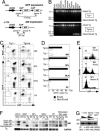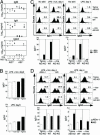Negative regulation of activation-induced cytidine deaminase in B cells
- PMID: 16477013
- PMCID: PMC1413812
- DOI: 10.1073/pnas.0510970103
Negative regulation of activation-induced cytidine deaminase in B cells
Abstract
Both class switch recombination (CSR) and somatic hypermutation (SHM) of the Ig genes require the activity of activation-induced cytidine deaminase (AID). Expression of AID is restricted to B cells in the germinal centers of the lymphoid organs, where activated B cells undergo CSR and SHM. We previously showed that constitutive and systemic expression of AID leads to tumorigenesis in T cells and lung epithelium, but not in B cells. This finding led us to suspect that transgenic AID may be inactivated at least in part in B cells. To address this issue, we generated conditional AID-transgenic mice that constitutively express AID only in B cells. Studies on the cross between the AID-transgenic and AID-deficient mice showed that abundant AID protein accumulated by constitutive expression is inactivated in B cells, possibly providing an explanation for the absence of deregulation of CSR and SHM in AID-transgenic B cells.
Conflict of interest statement
Conflict of interest statement: No conflicts declared.
Figures





Similar articles
-
Separate domains of AID are required for somatic hypermutation and class-switch recombination.Nat Immunol. 2004 Jul;5(7):707-12. doi: 10.1038/ni1086. Epub 2004 Jun 13. Nat Immunol. 2004. PMID: 15195091
-
Activation-induced cytidine deaminase: a dual role in class-switch recombination and somatic hypermutation.Eur J Immunol. 2003 Aug;33(8):2069-73. doi: 10.1002/eji.200324133. Eur J Immunol. 2003. PMID: 12884279 Review.
-
Activation-induced deaminase: light and dark sides.Trends Mol Med. 2006 Sep;12(9):432-9. doi: 10.1016/j.molmed.2006.07.001. Epub 2006 Jul 24. Trends Mol Med. 2006. PMID: 16861038 Review.
-
Evolution of class switch recombination function in fish activation-induced cytidine deaminase, AID.Int Immunol. 2006 Jan;18(1):41-7. doi: 10.1093/intimm/dxh347. Epub 2005 Nov 15. Int Immunol. 2006. PMID: 16291656
-
DNA targets of AID evolutionary link between antibody somatic hypermutation and class switch recombination.Adv Immunol. 2009;101:163-89. doi: 10.1016/S0065-2776(08)01005-5. Adv Immunol. 2009. PMID: 19231595 Review.
Cited by
-
Dangerous Liaisons: Gammaherpesvirus Subversion of the Immunoglobulin Repertoire.Viruses. 2020 Jul 23;12(8):788. doi: 10.3390/v12080788. Viruses. 2020. PMID: 32717815 Free PMC article. Review.
-
Regulation of immunoglobulin class-switch recombination: choreography of noncoding transcription, targeted DNA deamination, and long-range DNA repair.Adv Immunol. 2014;122:1-57. doi: 10.1016/B978-0-12-800267-4.00001-8. Adv Immunol. 2014. PMID: 24507154 Free PMC article. Review.
-
Altered pattern of immunoglobulin hypermutation in mice deficient in Slip-GC protein.J Biol Chem. 2012 Sep 14;287(38):31856-65. doi: 10.1074/jbc.M112.340661. Epub 2012 Jul 25. J Biol Chem. 2012. PMID: 22833677 Free PMC article.
-
The function of serine/threonine-specific protein kinases in B cells.Front Immunol. 2024 Oct 9;15:1459527. doi: 10.3389/fimmu.2024.1459527. eCollection 2024. Front Immunol. 2024. PMID: 39445011 Free PMC article. Review.
-
AID in Chronic Lymphocytic Leukemia: Induction and Action During Disease Progression.Front Oncol. 2021 May 10;11:634383. doi: 10.3389/fonc.2021.634383. eCollection 2021. Front Oncol. 2021. PMID: 34041018 Free PMC article. Review.
References
-
- Honjo T., Kinoshita K., Muramatsu M. Annu. Rev. Immunol. 2002;20:165–196. - PubMed
-
- Muramatsu M., Kinoshita K., Fagarasan S., Yamada S., Shinkai Y., Honjo T. Cell. 2000;102:553–563. - PubMed
-
- Revy P., Muto T., Levy Y., Geissmann F., Plebani A., Sanal O., Catalan N., Forveille M., Dufourcq-Labelouse R., Gennery A., et al. Cell. 2000;102:565–575. - PubMed
-
- Bachl J., Carlson C., Gray-Schopfer V., Dessing M., Olsson C. J. Immunol. 2001;166:5051–5057. - PubMed
-
- Fukita Y., Jacobs H., Rajewsky K. Immunity. 1998;9:105–114. - PubMed
Publication types
MeSH terms
Substances
LinkOut - more resources
Full Text Sources
Other Literature Sources
Molecular Biology Databases

